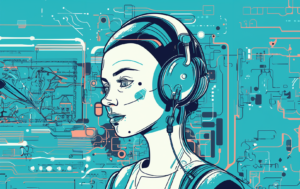Introduction
Welcome to the first blog post of Wood’Inc! As we step into the digital world together today, June 15, 2023, our journey begins with a subject at the heart of modern technological innovation: Artificial Intelligence (AI). If you’re intrigued by AI or want to understand why it’s causing a significant shift in virtually all industries, you’ve come to the right place. Let’s unravel this fascinating concept together.
Understanding Artificial Intelligence
At its core, Artificial Intelligence refers to machines or computer systems developed to mimic human intelligence. Think of tasks like learning, reasoning, problem-solving, perception, and even understanding and generating language. It’s not just a high-tech innovation for specialized use – AI is all around us, subtly integrated into our daily lives. It’s there when Spotify recommends songs based on your listening history, or when Gmail filters out spam emails, even when your smartphone’s voice assistant sets an alarm for you.
Distinguishing Between Narrow AI and General AI
Artificial Intelligence can be classified into two broad categories: Narrow AI and General AI.
Narrow AI, also known as Weak AI, is AI as we mostly know it today. These systems are designed and trained for specific tasks. Whether it’s voice recognition, image recognition, or recommendation systems, these are all examples of Narrow AI. It’s the AI that most of us interact with in our daily lives through various devices and applications.
On the other side of the spectrum is General AI. This is the type of AI you frequently encounter in sci-fi films, intelligent machines that can perform any intellectual task that a human being can. They’re theorized to have a level of autonomy, the ability to understand, learn, adapt, and implement knowledge from different domains. However, General AI is currently theoretical and not yet realized in practice.

Image generated by Midjourney
The Impact of AI: Why It Matters
You might wonder, “Why is there so much buzz around AI?” AI’s significance arises from its potential and existing applications across diverse fields:
- Healthcare: AI is now an integral part of healthcare, assisting with early disease diagnosis, predicting patient outcomes, personalizing treatment plans, and even assisting in surgeries. It’s revolutionizing patient care and medical research.
- Transportation: AI is at the forefront of autonomous vehicle technology, working tirelessly to bring the concept of self-driving cars to reality.
- Business: AI is reshaping the business landscape, providing advanced analytics for decision-making, automating customer service with chatbots, enhancing supply chain management, and much more.
Navigating the Challenges of AI
As with any powerful technology, AI presents challenges that society must navigate. The ethical use of AI, potential job displacement, privacy concerns, and the digital divide are all pressing issues that require attention and regulation. AI technology must be developed and used responsibly, keeping its impact on individuals and society in mind.
Wrapping Up
AI is not just another technological trend; it’s a powerful tool driving unprecedented changes in our society. We must understand this technology as it becomes more integrated into our everyday lives.
At Wood’Inc, we’re excited about the possibilities of AI and its applications in the digital landscape. Over the coming weeks, we’ll delve deeper into this subject. Exploring topics like machine learning, the role of AI in web development, the impact of AI on cybersecurity, and the ethical considerations of AI.
We hope this post has provided you with a basic understanding of AI and sparked your interest in the subject. Stay tuned for more in-depth discussions and feel free to reach out with any topics you’d like us to cover. The future is here, and we’re thrilled to explore it with you!




